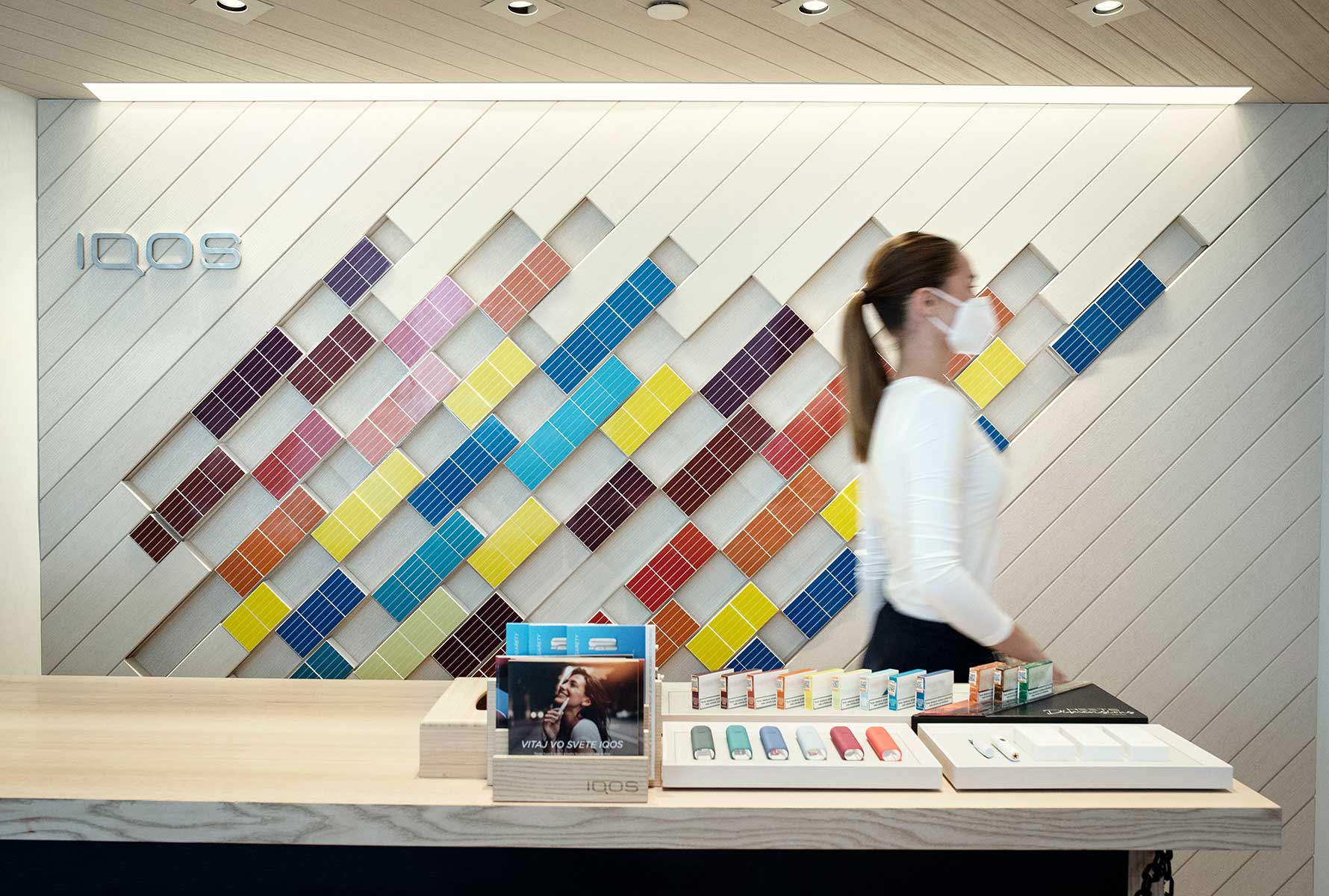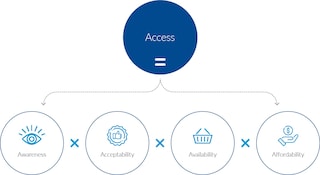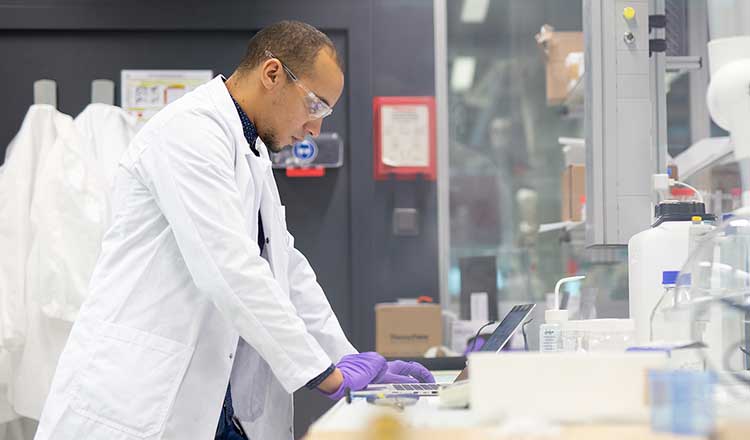| INTEGRATED REPORT 2020 |
For smokers to switch to smoke-free products, these alternatives must be accessible. Increasing accessibility means improving consumer awareness, as well as the acceptability, availability, and affordability of our smoke-free products.
Topic description
To provide adult smokers meaningful access to smoke-free products, we need to raise awareness of their benefits and make them sufficiently acceptable, available, and affordable so that smokers switch to them.
Access to smoke-free products is a tier 1 topic within our strategic pillar Innovating for better products.

Our progress in 2020
read more
The right thing to do
The business case
Our sustained investments in R&D, commercial capabilities, and the IQOS brand have created a competitive advantage, allowing our smoke-free products to lead the new category of better alternatives to cigarettes. By focusing the vast majority of our commercial deployment efforts on making sure that smokers who do not quit fully switch to better alternatives, we aim to reach as many adult smokers as possible in as many markets as possible; this includes the estimated 130 million PMI cigarette smokers, as well as the over 800 million smokers who buy competitor brands. This is not only the right thing to do, but the business case is clear: Our smoke-free product consumables drive higher net revenues and profitability per pack than cigarettes, with significant operating income margin benefits from increased scale as we start to generate attractive returns on our significant upfront and ongoing investments in developing the category. We are also gaining share of the total tobacco market, thereby increasing our current and future revenue base from which to generate income. Any delay in providing cigarette smokers access to smoke-free products means lower revenues and earnings per share for PMI.
Our aims:
>40 million
number of adult smokers globally who switch to PMI smoke-free products by 2025
>20 million
number of adult smokers in non-OECD countries who switch to PMI smoke-free products and stop smoking by 2025
100
number of markets globally where PMI smoke-free products are available for sale by 2025
Achieving our aims
It is our long-standing ambition that by 2025 at least 40 million smokers will have switched to PMI’s smoke-free products and stopped smoking, including at least 20 million smokers in non-OECD countries. This number can be much higher if more regulators make tobacco harm reduction an integral part of their tobacco control strategies, in addition to preventing initiation and encouraging cessation.
We have made good progress toward our targets. We estimate that by the end of 2020, a total of 12.7 million smokers—including 4.3 million smokers in non-OECD countries—had switched to IQOS and stopped smoking cigarettes.

Providing adult smokers access to our smoke-free products is the top priority at PMI. In addition to substantial resources, we dedicate the vast majority of management time to the topic, from our entire Company Management team to the management teams in every market in which we are commercializing or plan to commercialize IQOS.
In the four years following our 2016 announcement of our smoke-free vision, PMI’s smoke-free product shipment volume increased from 8 to 76 billion units. Simultaneously, the shipment volume of our combustible tobacco products contracted from 845 to 654 billion units over that period and smoke-free products played a very important role.
To succeed in making the world smoke-free, we need all adult smokers to have access to PMI’s smoke-free products. By access, we mean that:
- Smokers are aware of the benefits of smoke-free products
- The products are accepted by smokers as a viable alternative to cigarettes
- The products are conveniently available for sale to smokers
- Smoke-free products are affordable to smokers
In this context, a regulatory framework allowing the products to be sold and adult smokers to know that these products exist and are available is essential.
To achieve our objectives, we are leveraging our resources to—where we can—enhance the awareness, acceptability, availability, and affordability of our smoke-free products. Our commercial expenditure ratio is a good overall indicator of our efforts in this regard, showing how much of our total global spend on marketing, consumer engagement, and trade activities is dedicated to smoke-free products. In 2020, 76 percent of PMI’s commercial expenditures related to smoke-free products (up from 71 percent in 2019), far exceeding their share of total net revenues (23.8 percent). While PMI is doing everything under its control by shifting resources, government policy, and regulations should play a key role in enabling and facilitating access.
Our Chief Executive Officer heads our efforts to roll out smoke-free products across our markets globally. The team led by PMI’s Chief Consumer Officer brings together all consumer-facing experiences across the consumer journey, from trends and insights on acquisition channel strategy, to programs to deter relapse to cigarettes. In conjunction, our Commercial team, headed by PMI’s Senior Vice President, Commercial, develops, tests, and deploys the routes to market for smoke-free products. Meanwhile, the team led by our Chief Product Officer continuously develops and enhances PMI’s smoke-free products, drawing on consumer feedback. Importantly, our Operations team, led by our Senior Vice President, Operations, works to ensure our manufacturing capabilities meet the demand for smoke-free products.

Case study
Can innovative products like IQOS accelerate the decline of smoking?
Minimizing tobacco-related harm at the population level depends not only on the degree of risk reduction of the smoke-free products, but also on their adoption by adults who would otherwise continue to smoke. It is important that these people switch completely in large numbers, whilst product initiation by nonsmokers—including youth and ex-smokers—must be minimized. This case study responds to calls from researchers and public health policy experts for a better understanding of the population-level impact of the increasing availability and uptake of IQOS, our heat-not-burn product.
This online content about our Integrated Report should be read in conjunction with PMI’s 2020 Integrated Report. The information and data presented here cover the 2020 calendar year or reflect status at December 31, 2020, worldwide, unless otherwise indicated. Where not specified, data come from PMI estimates. Please also refer to 'About this report' on page 3 of the 2020 Integrated Report for more information. Aspirational targets and goals do not constitute financial projections, and achievement of future results is subject to risks, uncertainties and inaccurate assumptions, as outlined in our forward-looking and cautionary statements on page 145. In the 2020 Integrated Report and in related communications, the terms “materiality,” “material,” and similar terms, when used in the context of economic, environmental, and social topics, are defined in the referenced sustainability standards and are not meant to correspond to the concept of materiality under the U.S. securities laws and/or disclosures required by the U.S. Securities and Exchange Commission.




